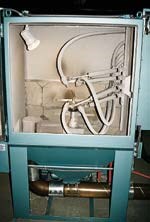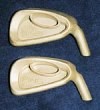PING Stays Away from the Rough
with Automated Blasting. An automated system provides consistency and control...
You do not have to be a golfer to appreciate the extreme care that a premier club manufacturer takes in the cosmetic appearance of its newest line of clubs. If you do play, you will take special interest in the finishing story behind one of the sport’s most anticipated new product introductions.
The unveiling of PING’s new i3 irons this year is the culmination of what the firm’s chairman and CEO John Solheim describes as “the longest and most comprehensive product introduction in the long history of our company.” PING’s history goes back more than 40 years to a putter invented by his father, Karsten Solheim, that made a unique sound when striking a golf ball, giving the company its name.
Featured Content
When golfers compare clubs, they are strongly influenced by the look of the product. When players purchase a premium club, they want the weaponry to stand out from the more common merchandise. A distinctive finish is considered one of the most critical elements of success in the club business.
The worldwide popularity of golf continues to rise. To capture their share of the enormous market for golf equipment, many club manufacturers believe they need a new look each year. Shifts take place in what is popular, but overall, the golf industry is a major hotbed of finishing activity and a great boon to numerous contract finishers.
PING is a prestigious name in golf, one that has endured many swings and fads in club finishing. The company’s fame is not just based on its high profile endorsements by celebrated professional golfers and exposure on worldwide pro tours over the decades. Unlike many brands, the company does all of the actual work in making its clubs from casting at its own foundry to welding to grinding to finishing and assembly. Among serious players, PING has earned a legendary reputation for innovation in design engineering and quality in every detail.
The weight of PING’s reputation and the scale of the launch of its i3 irons put a lot of pressure on the Arizona-based club maker’s product development and production planning teams, particularly in its all-important decisions about surface finishing and final appearance.
Early in the i3 iron project, PING evaluated a number of alternative surface treatments, including plating, painting, chemical etching and vibratory finishing. Blast finishing was another method considered. The company, Guyson Corp., Saratoga Springs, NY, provided a free blast testing service and feasibility analysis. After extensive testing, several exotic surface textures were produced using blasting techniques. The PING decision-makers agreed upon a dramatic new look for the i3. According to a company spokesman, “The blast finish gave the clubs a consistent finish. It also provided durability and aesthetics, all in one package.”
The unique appearance of the i3 irons has to be seen firsthand to be understood, but a lot of the visual appeal comes from the subtle reflectivity of the texture imparted by the blast shot-peening process. Far from rough, thousands of tiny dimples on the surface give the club a soft sheen glow that seems to emanate from the non-corroding alloy (17-4 stainless steel) itself.
Aesthetics are important to PING and its customers. PING is as passionate about its clubs as its customers are about theirs. Its concerns were just as strong about production matters. It wanted to know technical parameters such as exact nozzle used, blast pressure, gun angle, nozzle distance from the component and blast time, as well as details of the media and its screen size.
Some of PING’s chief concerns in selecting the proper blast equipment were process control and repeatability, since it insists on a strict standard of consistent quality in every club head and the flexibility to accommodate the full variety of geometries involved in making up to 15 i3 Blade and i3 O-Size irons for right- and left-handed men and women. If you do the math, that amounts to many separate processes.
Most of PING’s competitors that produce some of their finishes by blasting use bulk processing equipment, such as a tumble-belt wheelblast machine, or they rely on inconsistent hand-blasting methods. The economics that go with the latter have driven a large percentage of club makers (or their suppliers) to perform many manufacturing and labor-intensive finishing practices in other countries.
PING chose an alternative by investing in programmable, high-production automated blast equipment for the finishing area of its manufacturing facilities to process each club head individually. It wanted to keep all work under its direct control and generate the final finish with the greatest possible degree of consistency. Dozens of hand-blast cabinets were not a viable option, because of the anticipated volume of orders and because PING would not accept the inevitable variation in the quality of the results from manual processing. “In addition to the finish consistency and process control,” noted a company spokesman, “this system provided the employees the best working environment. Since it is pressurized, the machine is completely sealed. There are no dust particles contaminating the plant air.”
The blasting system has four spindles located around the perimeter of its rotary indexing table; each is fitted with a component-holding fixture. For each club head with a different angle or inside diameter of the hosel (part of the iron that mates with the shaft of the club), the production blast machine must have a set of four quick-change fixtures that will present the component to the blast in precisely the right orientation.
Blasting occurs at one station inside the machine. While the workpiece rotates at a controlled speed, it is exposed to blasts from four adjustable pre-positioned nozzles bracketed onto a precision ball-screw/ball-nut traverse mechanism that provides programmable linear movement in the vertical axis. The interior of the cabinet actually has three separated chambers that provide an entry vestibule to isolate the blast process on one side and automatic blow-off components on the other.
A light curtain at the load/unload workstation linked to the machine’s PLC not only protects operators from moving parts, but enables indexing and the start of the automatic blast cycle. This automatic feature helps keep the pace of production at maximum by eliminating delays for unnecessary operator movements.
PING’s surface finishing process requires direct pressure media delivery, in which the shot is held in a pressurized vessel, metered into a powerful airstream at the base of the tank and accelerated throughout its travel inside a single heavy-duty hose to the blast nozzle. The added expense of pressure blast, in terms of initial investment and equipment maintenance, is justifiable only when media particles must be delivered with greater kinetic energy in order to do more work at the higher velocity than is possible with direct pressure, or when a brisk production rate dictates the fastest possible cycle time.
The system includes a high-performance cyclone media reclaimer that separates dust and fractured media particles from reusable shot and a highly efficient cartridge-type dust collector of suitable capacity. Keeping more precise control over the size of the shot and maintaining its purity helps ensure the consistency of the texturing process.
In PING’s case, the media delivery system had two extra high-production features. One is a double-chambered pressure vessel that automatically recharges itself without interrupting the continuous flow of media to the blasting nozzles. It does not rob cycle time for refilling the pressure pot and helps ensure against uneven coverage in the fast-paced finishing operation. The other is a sensor-controlled storage hopper that automatically adds bead to the recirculating media supply as needed to prevent possible starvation of the working nozzles. This also provides insurance against unacceptable variations in the consistency of coverage.
Will PING’s investment bring big returns? Right now, the answer lies in the success of the i3 Series irons and the other clubs that bear the distinctive peened finish. Based on the enthusiastic response and early-bird orders received so far, PING’s manufacturing operations are running at full capacity.
To learn more visit Guyson Corp. of USA.
Take a tour on your visit to PING's official website on the Internet, www.pinggolf.com, to get a feel for the company's total dedication to its craft.






















